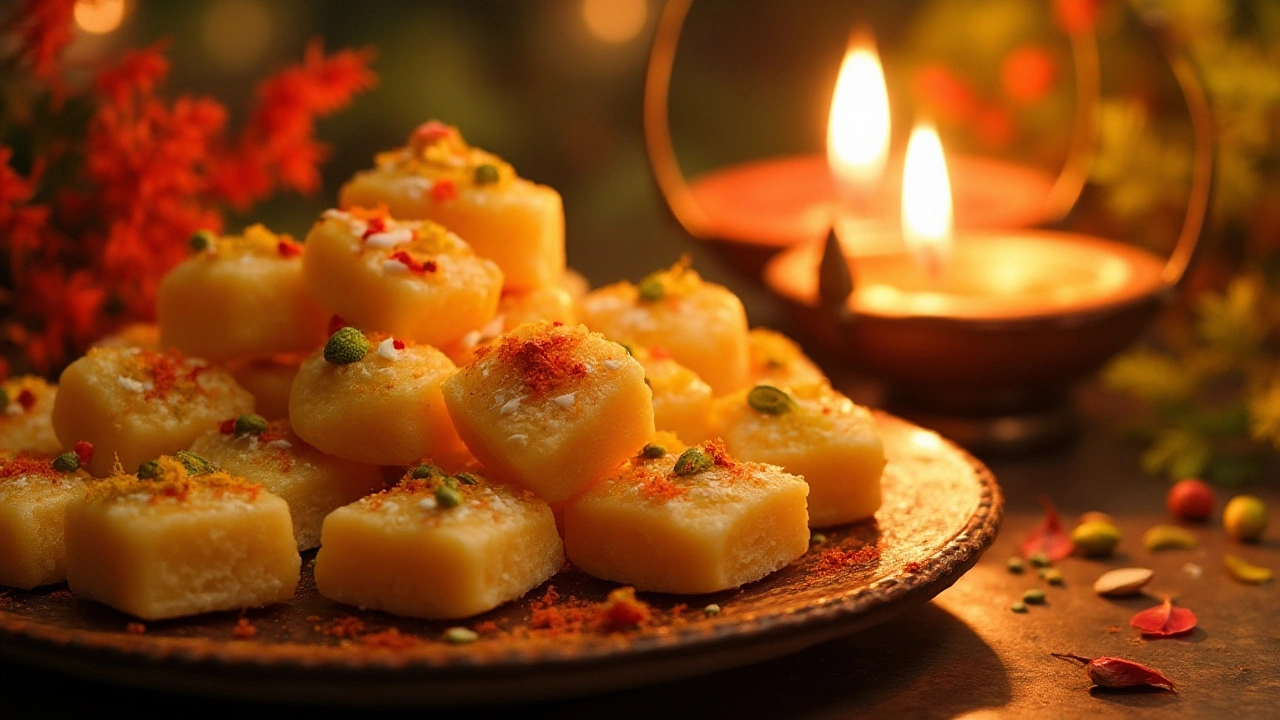Indian sweets, known for their rich flavors and vibrant colors, are an integral part of the country's culinary heritage. Often enjoyed during special occasions and festivals, these treats are loved by many. However, there's a myth that all Indian sweets are unhealthy. While some are indeed rich in sugar and fats, others can be quite nutritious. By choosing the right ingredients and preparation methods, it is possible to enjoy these delicacies without guilt.
Many traditional recipes can be adapted to fit a healthier lifestyle. Ingredients like jaggery, nuts, and milk offer nutritional benefits, and with a few tweaks, these sweets can be both delicious and nourishing. Let's dive into this sweet exploration, where tradition meets health and where taste doesn't have to be sacrificed.
- Understanding Indian Sweets
- Ingredients with Health Benefits
- Healthy Recipes You Can Try
- Balancing Taste and Nutrition
- Tips for Making Healthier Sweets
Understanding Indian Sweets
The world of Indian sweets is as diverse as the country's culture itself. These delicacies, often referred to as Mithai, are an essential part of Indian traditions, playing a significant role in celebrations and religious ceremonies. From the aromatic streets of Kolkata with its famous Rasgulla to the bustling alleys of Delhi offering mouth-watering Jalebis, each region in India contributes unique flavors and textures to this sweeping panorama of sweets. These sweets, known for their rich flavors and luxurious textures, typically involve distinct methods of preparation, often passed down through generations.
Indian sweets incorporate a diverse range of ingredients. Nuts, ghee, sugar, and spices like cardamom and saffron create depth and complexity in flavor. Milk and its derivatives are profoundly utilized, laying the foundation for popular sweets such as Paneer-based Rasgulla and Rasmalai. Lentils and beans are often used to lend texture and protein, seen in sweets like the soft and crumbly Mysore Pak. However, one shouldn't overlook the influence of sugarcane, not just for sweetness, but as a cultural staple.
As food historian K.T. Achaya mentions, "Sugarcane has been an integral part of Indian sweets since ancient times, shaping both culture and commerce."This interplay of ingredients highlights the creativity involved in crafting Indian sweets.
The preparation of these sweets is an art in itself, involving meticulous attention to technique and timing. Whether it's the perfect folding of dough for Gujiya or achieving the right consistency for Halwa, each step is crucial. Sweet-making is not just about following recipes; it is about understanding the science behind it. Knowing when to add cardamom or saffron for maximum flavor or grasping how the climate can alter the cooking process are skills refined over time. In bustling market areas of Indian cities, one can see expert halwais (sweet makers) at work, their experience apparent in the deftness of their hands and the precision of their measures.
Traditionally, Indian sweets are crafted with natural sweeteners like jaggery, offering a healthier alternative to processed sugars. Jaggery retains more minerals and is a less bothering choice for those concerned about glycemic indices. People today are more health-conscious and as a result, they often seek ways to enjoy these fragrant treats without the health drawbacks associated with high sugar consumption. By understanding these sweets’ foundational elements, it's easier to adapt recipes to healthier versions. The exploration of this delightful realm doesn’t just rest on taste and tradition; it finds ground in health as well. Let's delve deeper into this delicious journey where tradition meets wellness.
Ingredients with Health Benefits
When it comes to crafting healthy Indian sweets, the choice of ingredients can make a significant difference. A good place to start is with natural sweeteners that replace refined sugar. Ingredients like jaggery, honey, and dates not only add sweetness but also come packed with essential nutrients. Jaggery, a traditional unrefined sugar, is rich in iron and other minerals. It's widely used in many Indian households and offers a deeper, more complex sweetness compared to white sugar. Honey is another versatile sweetener; it's known for its antibacterial properties and is often used in Ayurveda for its medicinal benefits. Dates add natural sweetness and are a great source of fiber, perfect for making energy-filled sweets without the added guilt.
Nuts and seeds are another superfood category that can transform your sweets. Almonds, cashews, and pistachios are commonly used in Indian desserts like barfi and halwa. They add a delightful crunch and are packed with proteins, healthy fats, and essential vitamins like E and B6. These nutrients not only provide energy but also support brain health, making them a worthwhile addition. Sesame seeds and flaxseeds are rich in omega-3 fatty acids and can add a nutty flavor to sweets like laddoos. Including nuts and seeds boosts the nutritional profile and provides satiating qualities, ensuring you’re full longer.
"The key to a nutritious dessert is balancing indulgence with health, focusing on quality ingredients," says nutritionist Rujuta Diwekar, known for her advocacy of traditional Indian eating practices.
Dairy products like milk and ghee are staples in many traditional sweets. While ghee is known for its rich flavor, it also contains butyrate, which aids in digestion and has anti-inflammatory properties. Choosing full-fat milk over cream can lead to a richer taste without compromising on health. Incorporating paneer or even tofu for vegan options can give sweets a creamy texture and add a dose of protein. For those who are lactose intolerant, coconut milk or almond milk serves as an excellent substitute, keeping the creamy texture intact.
Do not overlook the role of spices and herbs, which are the heart of Indian cuisine. Cardamom, saffron, and turmeric are more than just flavor enhancers. Cardamom aids digestion and may help with metabolism regulation, while saffron is a potent antioxidant known for its mood-enhancing properties. Turmeric, widely celebrated for its anti-inflammatory benefits, can be melded into sweets for a golden hue and health boost. These spices not only add unique flavors but also contribute to the sweets' health potential. Incorporating them wisely can result in desserts that are both delightful and beneficial.
Some sweets can also benefit from adding fruits like mango, banana, and kokum. When included in desserts, these fruits offer natural sweetness and a variety of vitamins and antioxidants. Including them can enhance flavor profiles and provide a dose of necessary vitamins like vitamin C and potassium. When choosing healthy ingredients, a well-rounded, balanced approach ensures a sweet dish that's just as tasty as it is nourishing. By carefully selecting and combining its list of ingredients, it's possible to indulge your sweet tooth while maintaining a focus on health.

Healthy Recipes You Can Try
In the vibrant tapestry of Indian cuisine, sweets have always held a special place. They mark celebrations, offer comfort, and bring families together. But what if you could indulge in their sweetness without the nagging regret of unhealthy eating? Here are some delightful healthy Indian sweets recipes that merge traditional flavors with modern health-conscious ingredients. These are not just recipes; they are an invitation to savor the decadence while embracing nourishment.
Besan Ladoo with a Twist
Besan ladoos are a beloved treat made from roasted gram flour, sugar, and ghee. To give this classic a healthier spin, replace the sugar with jaggery, a less refined sugar option that retains its natural molasses and minerals. Alongside, use coconut oil instead of ghee, not only catering to vegans but also adding a nutty aroma. Roasting the gram flour until it turns a golden hue is key to developing the deep, nutty flavors that define this treat. Combine with jaggery, coconut oil, and a hint of cardamom, then roll into bite-sized balls that melt in your mouth, offering a guilt-free indulgence.
Nutrient-Rich Carrot Halwa
Carrot halwa, or gajar ka halwa, is a dessert enjoyed across India, combining grated carrots, milk, sugar, and ghee. To make it healthier, swap sugar with dates, which not only sweeten the dish naturally but also enhance it with fiber and essential minerals. Use almond milk as a substitute for full-fat milk, making the recipe vegan-friendly and introducing a subtle nuttiness that complements the sweetness of the carrots. Cook the carrots in almond milk until they soften, stirring in the pureed dates toward the end, rendering a beautiful, velvety texture. Add a sprinkle of chopped nuts for a delightful crunch and added protein, and you'll have a healthy twist on a cherished favorite.
Quinoa Kheer
Kheer is a traditional rice pudding that warms the soul. By substituting rice with quinoa, you create a nutritious dessert rich in protein and essential amino acids. Begin by rinsing quinoa thoroughly to remove its natural bitterness, then simmer it in a mix of skimmed milk and a dash of saffron, which offers a sweet aroma and golden color. Sweeten with honey or stevia, and finish with a sprinkle of cardamom and toasted almonds. This version not only reduces sugar and fat but also creates a dessert that's as nourishing as it is comforting.
"The first wealth is health." — Ralph Waldo Emerson
These recipes demonstrate that healthy sweets are not only possible but delightful. By thoughtfully selecting ingredients and making minor adjustments, one can transform traditional sweets into health-friendly indulgences. Once you start experimenting with these ideas, you'll discover the joy of creating desserts that satisfy cravings and support a balanced diet.
Balancing Taste and Nutrition
When it comes to Indian sweets, it's often a challenge to strike a balance between indulgence and health. However, with a few thoughtful choices, you can enjoy these delightful treats without compromising on nutrition. One of the most effective strategies is to substitute refined sugars with natural sweeteners. Ingredients like honey, jaggery, and coconut sugar not only add sweetness but also bring along a host of nutrients that benefit the body. Increasingly, people are leaning towards desserts made with whole grains or nut flours that offer additional fiber and protein, which steadies blood sugar levels better than their refined counterparts. There’s a world of flavors to be found in these healthy alternatives that can enhance both taste and texture without overwhelming sweetness.
Emphasizing wholesome ingredients is another tactic. Nuts and seeds are powerhouse components, rich in good fats, protein, and essential vitamins. Adding almonds, pistachios, or chia seeds to sweets not only gives them a delightful crunch but also boosts nutritional content. Dairy can also play a significant role. Opting for yogurt or low-fat milk instead of full cream can make a substantial difference in calorie count, while still delivering creamy textures. Dairy alternatives such as almond or coconut milk are becoming increasingly popular, providing a unique flavor profile and beneficial fatty acids. The key is to experiment and find combinations that suit your dietary needs while satisfying your taste buds.
Portion control is equally important in managing a healthy diet while enjoying sweets. Moderation allows one to relish a delicacy without the guilt of overindulgence. This technique encourages mindful eating, where you're more aware of each bite and appreciate the flavors much more. It dovetails with the concept of quality over quantity, where savoring smaller amounts of a high-quality, delicious sweet is far more satisfying than consuming large quantities of something less nutritionally sound. Some might find it helpful to serve desserts in smaller bowls or plates to naturally limit portions.
A powerful reminder from food enthusiasts is, "The secret to cooking a healthy dessert is not just in reducing sugar and fat but in boosting flavor.” Involving spices such as cardamom, cinnamon, and saffron taps into traditional flavors and provides antioxidants while intensifying the aroma. These spices lend depth and warmth to sweets, making them irresistibly delicious without the need for excessive sweetening. Customarily, Indian sweets are aromatic, and replicating these aromas can be achieved naturally through spices rather than added sugars.
For those who love experimenting, attempting to make sweets at home can be a rewarding venture. It gives you control over the ingredients and their quality, allowing for endless creativity in the kitchen. Opt for recipes that embrace fruit and vegetable additions, such as dates, figs, sweet potatoes, or pumpkin. Not only do these items enhance flavor, but they also contribute vitamins, minerals, and additional fiber, supporting the body's metabolic processes and ensuring sustained energy release. Remember, the joy of sweets is not just in their taste, but also in the nourishment they provide. Balancing taste and nutrition doesn’t have to be a compromise, but rather a delightful exploration of flavors that celebrate your taste buds and well-being in equal measure.

Tips for Making Healthier Sweets
Creating healthier versions of Indian sweets is a delightful challenge that invites creativity and experimentation in your kitchen. One of the best ways to start is by substituting refined sugar with natural sweeteners. Ingredients like jaggery, dates, or honey not only add sweetness but also bring additional minerals, making your desserts more nutritious. Jaggery, for example, is rich in iron and magnesium, providing health benefits that white sugar lacks. Using them in moderation allows you to enjoy the sweet taste without compromising on health.
Adding nuts and seeds to your recipes can enhance both flavor and nutritional value. Almonds, cashews, and pumpkin seeds can increase the protein and healthy fat content of your sweets. These ingredients also contribute to a delightful crunch, enriching the overall experience of savoring your desserts. Experimenting with different types of flour, like almond flour or coconut flour, can further boost the nutritional profile, offering a gluten-free alternative that is kinder to the digestive system.
Portion control is another key strategy when crafting healthier sweets. By creating smaller servings, you can control calorie intake while still indulging in your favorite treats. Consider using molds or pre-cut portions to ensure each piece is perfectly portioned. This helps maintain balance in your diet, allowing for enjoyment without overindulgence. Incorporating fruits like bananas or berries can add natural sweetness and moisture to your sweets, often reducing the need for additional sugars or oils.
"In the good old days, Indian sweets were made with wholesome ingredients like ghee and nuts, which are quite nutritious in the right quantities," says Dr. Ritu Kumar, a leading nutritionist in India.Including spices like cardamom or saffron not only enhances the taste but also brings a host of health benefits. For instance, cardamom is known for aiding digestion, while saffron is rich in antioxidants. These subtle additions can transform your dessert into a flavorful and healthful delight. Paying attention to cooking methods, such as choosing to bake instead of fry, can significantly cut down on unhealthy fats in your recipes.
Finally, staying informed and mindful about the ingredients you are using is crucial. Reading labels, understanding portion sizes, and being aware of your dietary needs help make smarter choices. Engage your senses and creativity to reimagine traditional recipes, turning them into nutritious desserts that bring joy and health in every bite. Remember, the journey to healthier sweets isn't about deprivation but about finding balance and celebrating flavors in their most nourishing form.
